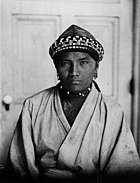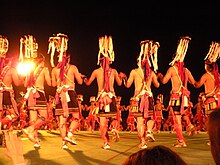Amis people
Pangcah Muqami | |
|---|---|
Taiwanese Aborigines |
| Taiwanese indigenous peoples |
|---|
 |
| Peoples |
|
Nationally Recognized Locally recognized Unrecognized |
| Related topics |
|
The Amis (
In 2014, the Amis numbered 200,604.
Traditional Amis villages were relatively large for Taiwanese
Identity and classification

The Amis people refer to themselves by two different ethnonyms. While those living in the East Rift Valley and Hualien County generally identify as Pangcah, which means "human" or "people of our kind," Amis living in coastal Taitung County employ the term Amis. Perhaps because of the official name, in 21st-century Taiwan, the term Amis is much more frequently used. This name comes from the word 'amis, meaning "north." There is still no consensus in the academic circle as to how "'Amis" came to be used to address the Pangcah. It may originally have been a term used by the Puyuma to refer to the Pangcah, who lived to the north of them. Another theory is that those who lived in the Taitung Plain called themselves "'Amis" because their ancestors had come from the north. This later explanation is recorded in the Banzoku Chōsa Hōkokusho,[5] indicating this term may have originated from a group classified by anthropologists as Falangaw Amis, the Amis group occupying territory from today's Chengkung to the Taitung Plain. Their closest genetic relatives appear to be the native Filipino people.[6][7]
According to Taiwanese Aboriginal History: Amis, the Amis are classified into five groups:
- Northern group (located on the Chihlai/Hualien Plain)
- Middle group (located west of the Hai'an Range)
- Coastal group (located east of the Hai'an Range)
- Falangaw group (located Chenggong and the Taitung Plain)
- Hengchun group (located on the Hengchun Peninsula)
Such classification, however widely accepted, is based simply on the geographical distribution and ethnic migration. It does not correspond to observed differences in culture, language, and physiques.
The People's Republic of China (PRC), which claims Taiwan as part of its own territory, considers all of the Amis as part of a Gaoshan ethnic group, one of the 56 ethnic groups of the PRC.
Culture
Traditions

Family affairs, including finance of the family, are decided by the female householder, in the Amis tradition. The most important traditional ceremony is the
Clothing
Traditional Amis clothes were made with cloth knitted with bark and banana threads with bamboo needles, and used wear-resistant linens and pelts. This evolved during the 20th Century with the arrival of
Traditionally black, Amis clothing has evolved during the 20th century to using more and more red, “for its perceived festiveness and compatibility with ethno-tourism”.[9] The coloring of necklaces distinguishes different Amis communities. Floral headdresses are also often used during special occasions, such as the harvest.
Representation in media
The musical project Enigma used an Amis chant in their song "Return to Innocence", on their second album, The Cross of Changes (1993). This song was used as the theme song of the 1996 Atlanta Olympics. The main chorus was sung by Difang and Igay Duana, who were part of a Taiwanese aboriginal cultural performance group.
Maison des Cultures du Monde had earlier recorded the singing of this group while on tour, and released a CD. This song was subsequently used by Enigma (although they did not note the ethnic origin of the song and the singers). The recording studio and the Taiwanese group filed a suit for copyright infringement, which was later settled by Enigma out of court. Ami singing is known for its complex contrapuntal polyphony.
Notable Amis people


- A-Lin, singer, songwriter
- Ngayaw Ake, baseball player
- Yu Chang, baseball player
- Lin Chih-chieh, basketball player
- Chen Chih-yuan, baseball player
- Yang Chuan-kwang, Olympic decathlete
- Kuo Dai-chi, baseball player
- Mayaw Dongi, Minister of Council of Indigenous Peoples (2013–2016)
- Difang and Igay Duana, husband-and-wife folk music duo
- Van Fan, singer, actor
- Ehlo Huang, actor and member of pop group 183 Club
- Jam Hsiao, singer
- Kuo Hsing-chun, weightlifter and Olympic gold medalist
- Ilid Kaolo, singer and songwriter
- Ayal Komod, singer
- Tseng Li-cheng, 2012 Olympics Taekwondo bronze medalist
- Show Lo, singer, actor, host
- Lin Man-ting, football and futsal player
- Ati Masaw, baseball player
- Teruo Nakamura, Taiwan-born soldier of the Imperial Japanese Army and the last Japanese holdout soldier of World War II
- Kawlo Iyun Pacidal, member of Legislative Yuan
- Kolas Yotaka, member of Legislative Yuan and Spokesperson for the Executive Yuan and the Office of the President
- Icyang Parod, Minister of Council of Indigenous Peoples
- Yang Sen, baseball player
- Sufin Siluko, member of Legislative Yuan
- Suming, actor, singer, songwriter. His music features elements from traditional Amis culture. Founder of the Amis Music Festival.
- Li Tai-hsiang, composer and folk songwriter[10]
- Tank, singer
- Tseng Te-Ping, singer
- Chin-hui Tsao, baseball player
- Dai-Kang Yang, baseball player
- Wei-Chung Wang, baseball player
- Huang Weijin, singer, actor, host
See also
References
- ^ Chia-chen, Hsieh; Wu, Jeffrey (15 February 2015). "Amis Remains Taiwan's Biggest Aboriginal Tribe at 37.1% of total". FocusTaiwan.tw. The Central News Agency. Retrieved 30 April 2015.
- ^ "Table 28: Indigenous Population Distribution in Taiwan-Fukien Area", National Statistics, Republic of China, Taiwan: Directorate General of Budget, Accounting and Statistics, Executive Yuan (DGBAS), archived from the original on 12 March 2007, retrieved 30 August 2006.
- ^ "Ami". Ethnologue.
- ISBN 9780313288531.
- ^ "Survey Reports on the Savages", Banzoku Chōsa Hōkokusho 蕃族調査報告書, vol. 8, Taihoku (Taipei), 1913–1918, p. 4
{{citation}}: CS1 maint: location missing publisher (link). - PMID 15984912.
- PMID 11170891..
- ^ "Amis Harvest Festival Held in East Taiwan". The China Post. 28 July 2005. Archived from the original on 11 November 2016. Retrieved 8 April 2011.
- ^ "Traditional Amis clothing restored through workshop - Taipei Times". www.taipeitimes.com. 8 August 2015. Retrieved 15 December 2023.
- Straits Times. 3 January 2014. Archived from the originalon 5 January 2014. Retrieved 3 February 2014.
Further reading
- Hsu, Mu-chu 許木柱; Liao, Shou-chen 廖守臣; Wu, Ming-i 吳明義 (2001). Āměizú shǐ piān 阿美族史篇 [Taiwanese Aboriginal History: Amis] (in Chinese). Nantou shi: Taiwan sheng wenxian weiyuanhui. ISBN 957-02-8003-4.
- "Amis". Council of Indigenous Peoples. 20 December 2010. Retrieved 15 December 2023.
External links
- Taiwanese government page on the Amis Archived 4 September 2011 at the Wayback Machine
- Amis Festivals
- Website dedicated to a documentary shot in the Amis village of Tafalong (Taiwan East Coast)
- Shamanic Healing among the Amis and Contemporary Christian Healing in the Spirit Archived 16 February 2012 at the Wayback Machine
